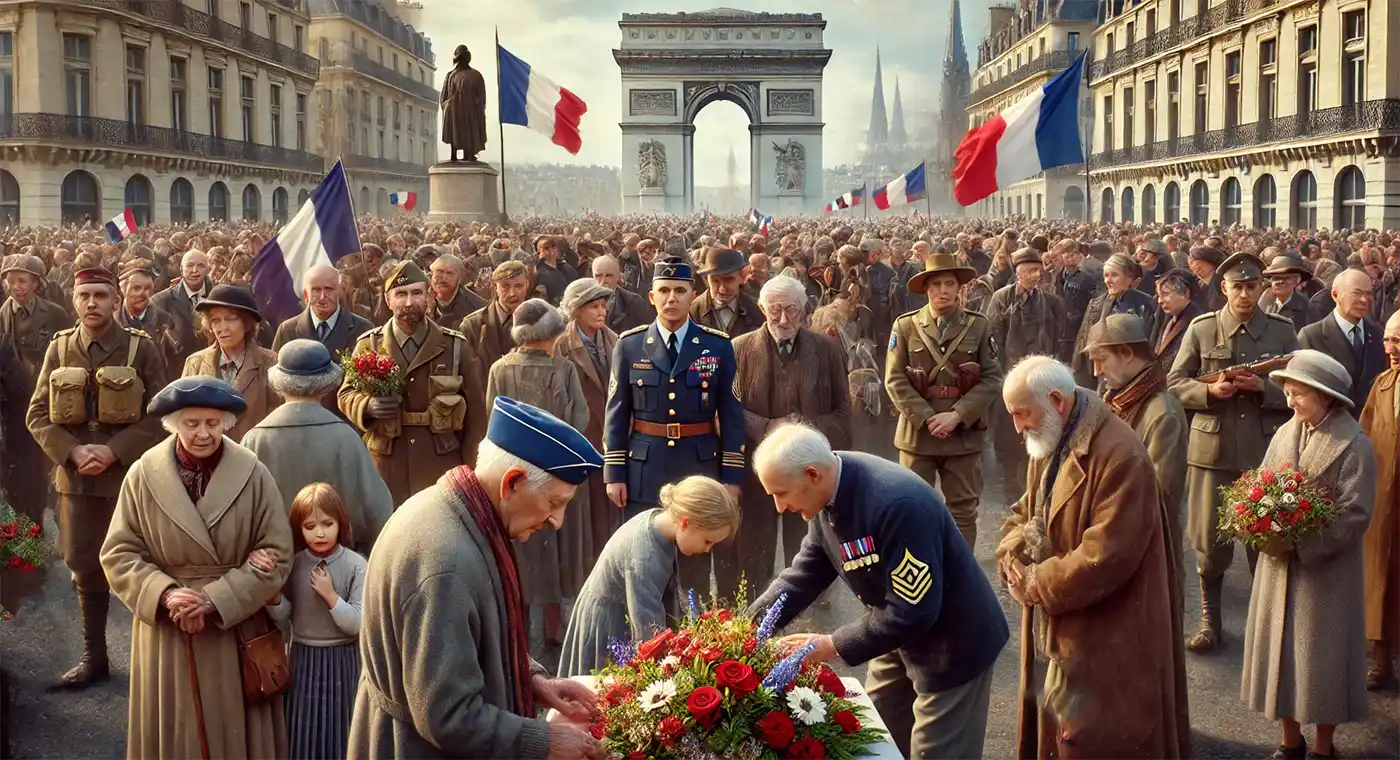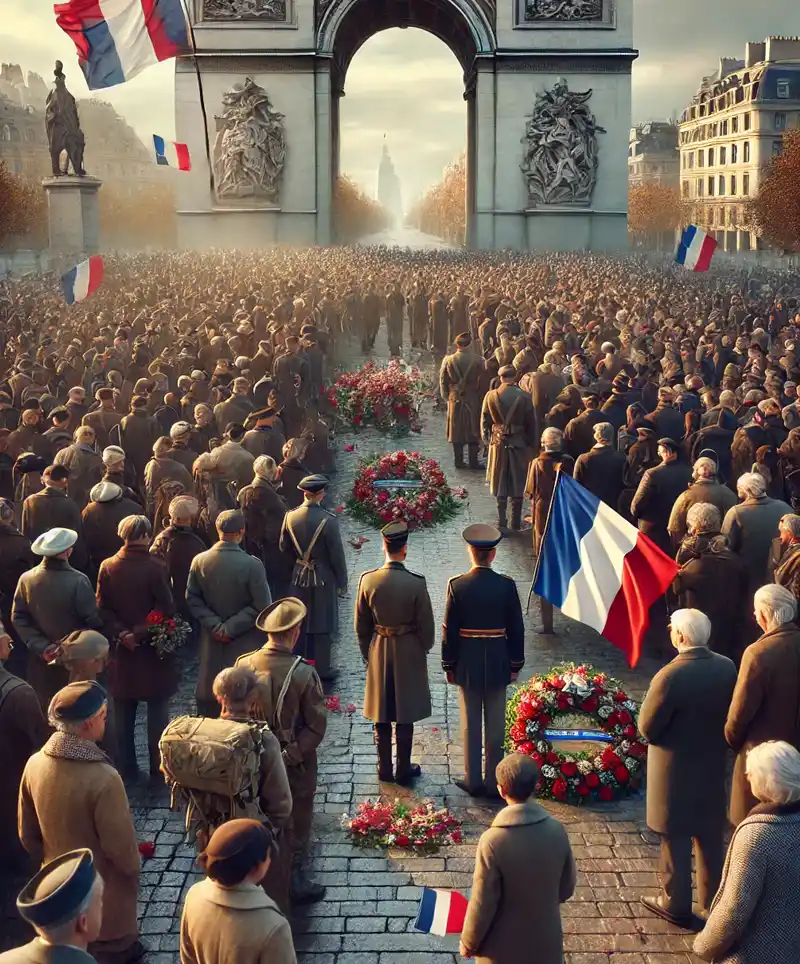The End of the Great War
Armistice Day, known in French as Jour de l'Armistice, is observed annually on November 11th to mark the end of World War I. On this day in 1918, at the 11th hour of the 11th day of the 11th month, Germany signed an armistice with the Allies, bringing a halt to the fighting on the Western Front. The signing took place in a railway carriage in Compiègne Forest in northern France, symbolizing the end of one of the most devastating conflicts in history.
For France, Armistice Day commemorates not only the sacrifices of soldiers who served during World War I but also the national resilience and the hope for lasting peace. This day is particularly significant to the French people, as much of the war’s destruction took place on French soil, leaving lasting impacts on families, cities, and the cultural landscape.
Armistice Day Celebrations in France
Every year on November 11, the French observe Armistice Day with solemnity and respect. The country comes together to remember the soldiers who lost their lives and to honor the end of hostilities. The most prominent ceremony occurs in Paris, at the Arc de Triomphe, where the French President leads a national commemoration attended by government officials, military personnel, and veterans.
The Arc de Triomphe, located at the western end of the Champs-Élysées in Paris, is France’s central symbol of military valor and remembrance. Beneath the arch lies the Tomb of the Unknown Soldier, a poignant tribute to those who fell in World War I and remain unidentified. On Armistice Day, a ceremonial wreath is placed on the tomb, and the eternal flame, first lit in 1923 to symbolize undying remembrance, is rekindled. This flame is maintained year-round, but on Armistice Day, it becomes the focal point of national mourning and reflection.
At 11:00 a.m., a moment of silence is observed across the country. In Paris, this silence is part of a larger ceremony that includes military honors, speeches, and the laying of wreaths. Schoolchildren and veterans’ associations often participate, highlighting the importance of passing the memory of war and its lessons to younger generations.

Local Commemorations Across France
Beyond Paris, towns and villages across France hold their own commemorative events. Nearly every French town has a monument aux morts (war memorial), often adorned with the names of local soldiers who died during World War I. On Armistice Day, these monuments become gathering points for communities, where residents lay wreaths, observe moments of silence, and pay respects to their fallen ancestors.
These smaller ceremonies help maintain the personal connections to the history of the war, fostering a sense of community and continuity. They reinforce the idea that Armistice Day is not only about the past but also about educating future generations on the horrors of war and the importance of peace.
The Red Poppy and the Bleuet de France
While the red poppy is a common symbol of remembrance in the United Kingdom, Canada, and other Commonwealth countries, France has its own emblem of remembrance: the bleuet de France, or cornflower. Both flowers grew abundantly on the battlefields of France and Belgium during World War I, becoming symbols of resilience amidst destruction.
The cornflower has come to symbolize the solidarity and sacrifice of French soldiers. It is worn on Armistice Day, and proceeds from the sale of bleuet de France pins go toward supporting war veterans, victims of terrorism, and their families. In recent years, there has been renewed interest in the cornflower symbol, with many French citizens embracing it as a national mark of respect.
Armistice Day Around the World
While Armistice Day is particularly significant in France, it is part of a broader tapestry of remembrance observed worldwide:
-
Veterans Day (United States): The United States also marks November 11 as a day to honor veterans, but it includes all who have served in the military, not only those from World War I. The focus is on appreciation for service and sacrifice, with ceremonies, parades, and moments of silence across the country.
-
Remembrance Day (United Kingdom, Canada, Australia, New Zealand): Many Commonwealth countries observe November 11 as Remembrance Day, commemorating soldiers who died in both World Wars and other conflicts. The red poppy is worn widely, and ceremonies include the traditional “Last Post” bugle call, symbolizing the end of the day and, metaphorically, the end of life.
French Memorial Sites Connected to Armistice Day
The significance of Armistice Day is preserved in numerous memorials and historic sites across France, reminding people of the war’s legacy and the importance of peace:
-
Verdun: The Battle of Verdun in 1916 was one of World War I’s longest and most brutal conflicts. Today, Verdun is home to memorials and cemeteries that honor the soldiers from both sides who lost their lives in this devastating battle.
-
Somme: The Somme battlefields saw some of the highest casualties in the war, including soldiers from France, Britain, and other nations. Today, the region hosts several cemeteries and memorials, serving as somber reminders of the cost of war.
-
Compiègne: The very spot where the armistice was signed is memorialized in Compiègne. Visitors can see the historic railway carriage where the treaty was signed and learn about the events that led to the end of the war. This site stands as a testament to both the peace agreement and the solemnity of wartime sacrifice.
Armistice Day remains a public holiday in France, and its legacy continues to shape French society. The day reminds people of the sacrifices of the past, while also fostering a commitment to peace in the future. Schools often include lessons on the World Wars, the significance of the armistice, and the importance of remembrance.
In French culture, Armistice Day is a day of national unity, a time for individuals of all ages to connect with the sacrifices made by previous generations. It also serves as a reminder that peace is not to be taken for granted. The hope is that, through honoring history, future conflicts may be avoided.
How to Honor Armistice Day
For those in France or anyone looking to honor Armistice Day, there are several meaningful ways to participate:
-
Attend a Ceremony: Participating in a local or national Armistice Day ceremony is a way to join with others in respect and remembrance.
-
Observe a Moment of Silence: At 11:00 a.m. on November 11, a minute or two of silence is observed across France, allowing people to reflect on the sacrifices made by soldiers and the impact of war.
-
Wear the Bleuet de France: Show solidarity by wearing the cornflower symbol, supporting the bleuet charity, and raising awareness about veterans and victims of terrorism in France.
-
Visit a War Memorial: War memorials across France honor those who served. Visiting one of these sites offers a chance to connect with history and reflect on the value of peace.
Armistice Day holds profound meaning in France as a day of remembrance, unity, and reflection. It honors those who sacrificed their lives, serves as a reminder of the consequences of war, and calls for continued peace. As the memory of World War I fades with time, Armistice Day remains a vital part of French heritage, ensuring that the lessons learned and the sacrifices made are never forgotten. In France, November 11 is not merely a date on the calendar—it is a moment of collective respect for history, a day of remembrance, and a commitment to peace for future generations.
Please Share our Content
















 "Sláinte!" is a traditional Irish expression used as a toast, equivalent to "Cheers!" in English.
"Sláinte!" is a traditional Irish expression used as a toast, equivalent to "Cheers!" in English.